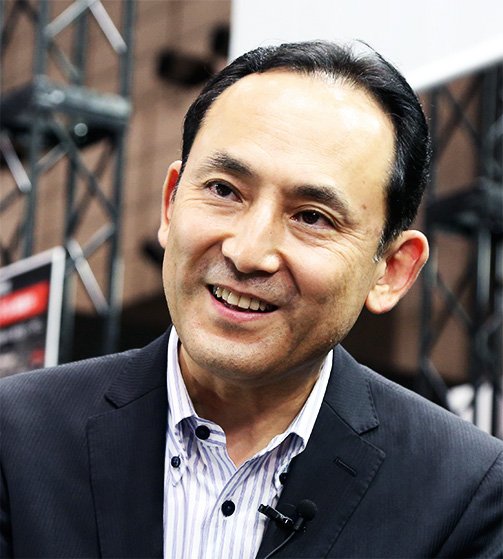Oct. 27, 2016
Shinichi Yasui, Chief Engineer for the 10th and 11th generation Corolla


A Sudden Appointment
When I first joined the company, the Corolla was already an emblematic Toyota model. To be honest, for a few years after I was hired, whenever I looked at the Corolla development team from my place in a separate department, I thought to myself, "Wow that looks tough."
I started out at the Development Planning Division, where I helped develop safety equipment such as air bags. Next, I moved on to design seats and seatbelts in the Body Design Division, and was later transferred to the Product Planning Division, where I worked on compact cars such as the first-generation Vitz and the bB, as well as the FunCargo and the ist.
Afterward, I was assigned to the Corolla's product planning team. Until then, I had worked on models with very unique personalities which were targeted for younger generations, such as the FunCargo, the bB, and the ist. Frankly, I thought, "Why me?" This was because I was entrusted with the Corolla – a traditional model. However, it dawned on me that it might have been because I was in-charge of creating more unique cars previously, that I was given this responsibility.

The True Meaning of a "Global Model"
It was right at the time when the concept for the tenth-generation model had been discussed, and the Chief Engineer at the time was Ken Yoshida. When he sent me on a business trip Mr. Yoshida said to me, "You don't know anything about the Corolla, so go overseas and take a careful look." I only knew about the Corolla that was designed for the Japan market, so my impression was that it's a vehicle that the older generations would buy. However, I was really surprised when I went overseas. In some countries, the Corolla is popular among families with kids, while in others, it is popular among younger generations. It is as though there is an infinite variety.
The moment I saw that, I realized the true meaning of the phrase, a "global model." I remember something Mr. Yoshida said to me when I joined the Corolla development team. He told me that Mr. Tatsuo Hasegawa (chief engineer of the first-generation Corolla) wrote on a piece of colored paper, "The Corolla: for the happiness and welfare of the people of Earth." This was an expression of the raison d'être of why the Corolla exists. Anywhere in the world where the Corolla is, people are moving along with their lives within the overarching constant movement of the economy. I then realized that this is why the Corolla has grown globally.

A Sustained Focus on Upgrading the Eleventh Generation despite Economic Crisis
It was after this experience that I had begun working on developing the eleventh-generation Corolla. When the marketing research was conducted for the tenth generation, we received feedback from customers that "while the Corolla is a good car, it doesn't create much anticipation or excitement". Our customers wanted something that would make the Corolla more attractive. Hence, we came up with an idea in the middle of the development for the eleventh-Corolla: to extend the wheelbase of the overseas development model by 100 mm. This was at the time of the collapse of Lehman Brothers, so the economic situation was not favorable, and we had a hard time convincing the company to go along with our idea as there was a principle of controlling investment to a level as low as possible. That's because if we did extend the wheelbase, wide-ranging changes on the factory production lines in 16 locations worldwide would have been necessary.
However, there was a chance that extending the wheelbase would make the body even more stylish, and more importantly, it would make for a more spacious interior. I thought that if such a need exists, then an automaker should build a car that meets those expectations. So despite the global financial crisis, we managed to convince the company that we had to do it then.
The Corolla is an affordable car, so people may believe it's made in the known, prevailing way. However, at times, it has been outfitted with new mechanisms and electronic devices by lowering the cost with its high volume before high-end models were.

The 11th Generation Corolla
Tackling Challenges is Inherent to the Corolla Spirit
I think these challenges have been around since the first-generation Corolla. Its red interior was a loud design element that is not really suited to as an affordable car of its nature, right? Well, if you faithfully reproduce the color from that time, you find that the interior was an elegant red with a distinctive texture, certainly not a garish hue. So we tried using that red for the leather seats for the 50th anniversary Corolla which we had launched in the Japanese market in 2016.
I have spent over half of my career at Toyota with the Corolla. It feels like I was hired by Corolla Corp. and not Toyota. I aspire to continue working with the Corolla and build a car that consistently meets global needs.

Shinichi Yasui, Chief Engineer for the 10th and 11th generation Corolla
Mr. Yasui was hired by Toyota Motor in 1988. After designing air bags, seats and seatbelts, Mr. Yasui was transferred to product planning in 1997, where he was in charge of compact cars like the first-generation Vitz and bB, along with the FunCargo and the ist. In 2002, he was assigned to product planning of the Corolla as a concept planner for the tenth-generation Corolla. In 2006, he was appointed the Chief Engineer for the tenth- and eleventh-generation Corollas (for overseas markets). Mr. Yasui became the Chief Engineer for all Corollas, including domestic versions for the Japanese market, in 2013. In April 2015, he became Executive Chief Engineer and Executive General Manager. Since 2016, Mr. Yasui has been the Executive General Manager of product planning at the Mid-size Vehicle Company.



























